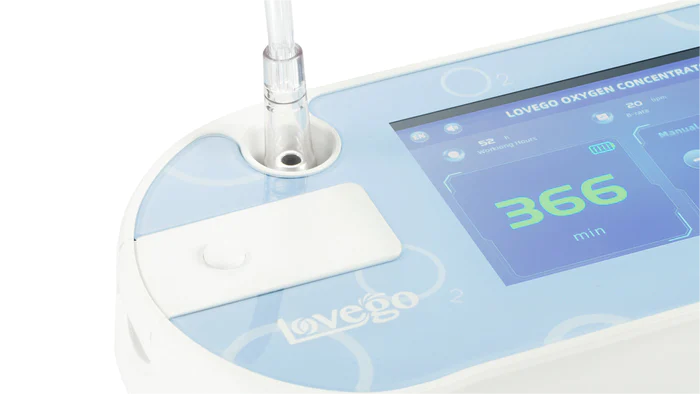An oxygen concentrator is an essential medical device for many patients who require supplemental oxygen. At the heart of the machine is a filter, which cleans the air before it is concentrated into an oxygen-rich gas for the patient to breathe.
Replacing this filter regularly is crucial to ensure the oxygen concentrator works properly. However, many patients are unsure when exactly the filter needs changing or cleaning. This article will provide key information on the role of the oxygen concentrator filter, how often it needs maintenance and clear signs that it requires replacement.
What Is the Function of a Filter in an Oxygen Concentrator?
The filter in an oxygen concentrator serves a vital purpose - to trap impurities in the air before concentration. Ambient air contains dust, pollens, pet dander, smoke particles, and other contaminants. Without filtration, these impurities would enter the oxygen stream and the patient's lungs.
The filter protects the internal components, too. Dust and particles can damage the concentrator's air compressor, valves, and separators over time. Proper filtration ensures clean, uncontaminated oxygen delivery and extends the machine's lifespan.

How Often Should You Clean the Filter in an Oxygen Concentrator?
For moderate usage (5-10 hours daily) in average conditions, the filter should be cleaned every 2-3 months. Light users may need this maintenance less often, such as every 4-6 months.
However, filters in dusty rural areas or high-pollution cities may need cleaning monthly, likewise for heavy usage over 10 hours per day or multiple users. Pet owners and smokers also have more contaminants, necessitating more frequent filter maintenance.

How Do You Clean the Filter in an Oxygen Concentrator?
Cleaning oxygen concentrator filters is quite straightforward. First, unplug the machine for safety. Open the filter housing by releasing the clips or screws. Slide out the old filter without touching the filtration fabric.
Clean the empty housing with a dry cloth before inserting the replacement filter. For models with reusable filters, use pressurized air, gentle water, or a mild detergent based on manufacturer guidelines. Rinse and dry completely before reinstalling.
Take care not to bend, tear, or damage reusable filters when cleaning. Only handle the rigid outer frame. After cleaning or replacing, close the housing and restart the oxygen concentrator per standard procedure.
How Long Does the Filter in an Oxygen Concentrator Last?
With routine cleaning, most oxygen concentrator filters should last 9-12 months under normal circumstances. Well-maintained units in clean environments can sometimes operate properly for 2+ years without needing filter replacements.
However, factors like heavy use, extreme dust or pollution, smoke exposure, and pet hair take a toll. These demanding conditions may shorten filter life to just 6-8 months before flow and performance decline noticeably.
When to Replace the Filter in an Oxygen Concentrator
The most common indicator is a gradual drop in oxygen flow or pressure over time. Patients may notice it takes longer to reach their normal oxygen saturation levels or feel short of breath more easily. This slow decline suggests the filter is becoming obstructed with particles and restricting air intake.
An increase in the machine's noise when turning on or a louder humming sound while running can also signify excess filter contamination. The extra effort to draw air through a blocked filter creates more vibration and noise.
Most devices have a check filter light that illuminates when the flow is impeded. If this indicator remains on after cleaning the device, the declining performance likely means the filter needs replacing.
Odd smells coming from the oxygen output are a sure sign of problems, too. A musty, dirty scent indicates debris and microbes accumulating in the aged filter. Replacing it eliminates undesirable contaminated air.
Upon visual inspection, tears, rips, thick particulate accumulation, black discoloration, bacterial growth, or water damage point to a filter needing replacement. Even if the flow seems adequate, deteriorating filters run the risk of releasing debris into clean oxygen, so they should be swapped out.
Beyond these indicators, manufacturers generally recommend changing filters every 12 months as preventative maintenance. Setting a reminder based on installation dates and sticking to this annual routine prevents unexpected issues down the road.
Though an existing filter may seem fine externally, microscopic gaps can still allow impurities through over time. Just as with changing the oil in a car, regular filter changes help optimize performance and head off deterioration issues. By staying ahead of any degradation, patients can breathe easier knowing their devices deliver the intended oxygen concentrations day after day.
The Bottom Line
The humble filter plays a major role in oxygen concentrator functionality, safety, and longevity. While cleaning and replacing these filters takes minimal effort, neglecting this crucial maintenance causes a significant performance decline over time.
By understanding filter roles, adhering to cleaning recommendations, and watching for telltale signs of worn filters, oxygen concentrator users can optimize their devices. Proper filter care translates directly into easier breathing and enhanced quality of life. Monitoring usage and maintaining the filter guarantees patients receive the full benefits of their prescribed oxygen therapy year after year.





Leave a comment
This site is protected by hCaptcha and the hCaptcha Privacy Policy and Terms of Service apply.